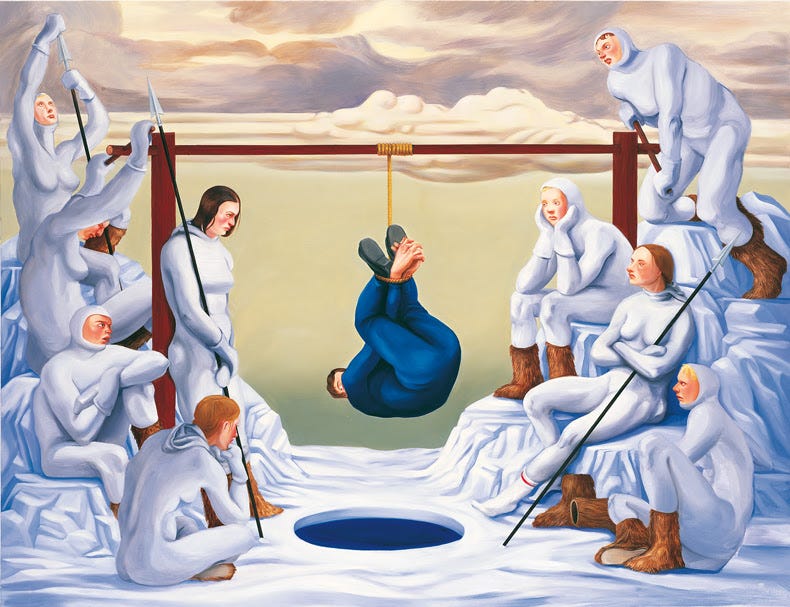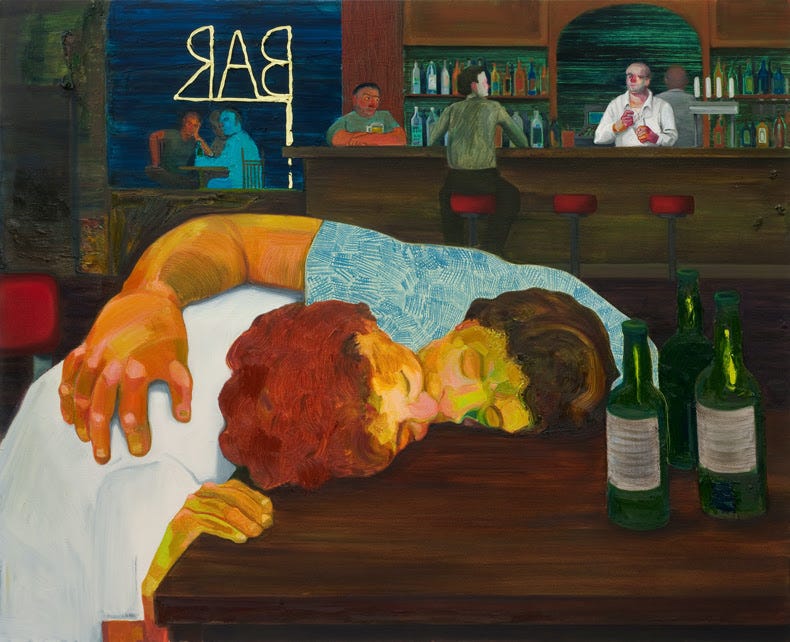Ekphrasis 1: On being a Bad Writer and Nicole Eisenman
From Success to Obscurity, Nicole Eisenman, 2004.
Somewhere along the last few months, I appear to have picked up the belief that I am a Bad Writer. Not in a self deprecating, “aw shucks little old me” way, but in a genuine, "I-am-an-amateur-who-writes-flimsy-things-not-fit-for-consumption" way. It is a puzzling, frankly bizarre belief. I write all the time, in big and small ways. I pitch editors who don't always accept my ideas, but at least respond. I have four different book projects I'm working on. If I am not thinking about writing, I am thinking about thinking about writing, and by that I mean I experience that little fringe of tickle in the back of my mind, the you could be doing the other thing instead patter of my subconscious. If a student told me all these things and then told me "But I believe I'm a Bad Writer" I would laugh them out of the classroom.
And yet! The other day I misunderstood an assignment I'd been given and spent the remains of the day spiraling about what a blundering mess I was. I moped about it through dinner. I talked forever to Jack about how this was proof that I was obsolete and bad at my craft. I was, frankly, not the best company.
Then, the next morning, I took a walk and did some journaling. I went back and saw that I hadn't simply been too dull to understand what I was tasked to do. Instead there was a genuine miscommunication which wasn't really anyone's fault. Still, at one small misstep, I leapt into sabotaging myself, subjecting myself to a barrage of abuse, the kind of global, all-encompassing condemnations I've been told make for an unfair fight. I saw, in the midst of my tantrum-wreckage, the glinting of this strange belief: I AM A BAD WRITER. Oh, I thought to myself, how did that get here?
I've since been trying to trace where it was that I picked this up. Here’s one theory: after the birth of my daughter, I felt alive with creativity, burning up with the ecstasy of creating a human, setting sparks alight into all my other creative endeavors. But then the drudgery, the sleeplessness and the timelessness of childcare crept in, creating a strange trap. I had all this energy and intention, but no time to perfect it or make it go anywhere. I wanted desperately to be seen, and also I was afraid of putting myself in your view. I felt confused, desperate, lonely, listless. How to make sense of all that creativity churning away in my shoulders and arms with nowhere to go? What to do with the desire to preen, to be photographed, to be in the limelight, with the twinned fear that I had changed, become something unrecognizable and undesirable? I suspect I took this frustrated feeling and assigned it a faulty logic; all of this was the sad and slow realization that I was a Bad Writer.
Fishing (2000), Nicole Eisenman
Which is why I'm writing this Substack. I mentioned my students earlier and a piece of advice I find myself always giving them (and now needing to give myself) is that the only bad writer is one who doesn’t write. Writing is an endurance game, a game of making so many imperfect things over and over until slowly, you get better. So I’m taking that up and getting out of my own way. I've decided to write bi-monthly, less formal, conversational pieces on this substack. This is the first of those installments, a column I'm tentatively calling ekphrasis. Ekphrasis is a literary description of art. Ekphrastic poetry, for example, is a poem inspired by, usually, a painting. Take this poem by Angel Nafis, catalyzed by Carrie Mae Weems' Kitchen Table Series, a favorite of mine. Ekphrasis, on my substack, will be writing inspired by and about various cultural objects. Today, I'm writing to you from What Happened, a retrospective of Nicole Eisenman's work.
I wish I could say to you that I knew who Eisenman was and that's why I went to the MCA but it was pure happenstance. We were downtown. We were full of dim sum and I had a complimentary admission ticket burning a hole in my pocket. (Here’s a good three stop itinerary: dim sum lunch at Ming Hin; stroll around the MCA; finish with a coffee or cheeky drink at Marisol downstairs to discuss what you saw.) It was a surprise to fall deep in love with her images, vivid and fleshy. Their shapes, their colors, their frank point of view. Here was work that was unafraid to depict all the indignities of the human experience.
Eisenman is a lesbian Jewish artist, currently living in Brooklyn. The sketches of her early work in the museum feature muscled women fighting, shouting, fucking. Her line reminds me at once of the cartoon-y outline of Mr. Monopoly and the fleshy crowd of a Michaelangelo frieze. In painting, these lines become a sense of humor, a way of telling an uncomfortable, curious joke in a single frame. I noted a few paintings to take back to my classroom as prompts. (The one above of the women trussing a business man over an ice hole is one such painting. My prompt: what led to this moment? what happened after? And what is the conversation happening between the women? You can try it out if you’d like.)
Sloppy Bar Room Kiss (2011), Nicole Eisenman
Then there was the painting I embedded in the beginning of this letter; From Success to Obscurity. One doesn’t need the museum placard to guess where a painting like that came from; the clay constipated looking figure reading a letter is an echo of every grant and submission rejection. It’s perhaps even a reflection of a once-was-lover, reading the cooled feelings of someone who once loved them back. For me, swaying with a sleeping baby on my chest, I saw my own, ungainly self. The sickly gray-green of the canvas was a transmutation of my self indulgent nausea, checking my inbox over and over for some good news. I want to exfoliate this figure. I want to sand them into flexibility. I want to smooth their crunched up joints and get them liquid again; forget success, I’d like to say, but reject obscurity. Here you are, after all, aren’t you?
Because that’s the other thing about these Eisenman paintings. They show us small, hairy moments of embarrassment but they are also full of a vivid, electric color that is hard to read as anything but a total and complete present-ness. In the same way misery engulfs Obscurity, here is another reminder that there is simply much more to life than being successful. Two women kiss, open-mouthed, on a bar table, becoming one, thrumming, creature in their ardor. Neon melts off a night time window. I bet that bar table is sweaty, I bet it’s summer outside. I can feel that humid wanting on my own skin, a skin I want to give up and join to someone else. Obscurity can be delicious. If there is a way to fade I want to fade into nothing, to let myself drip, lovingly, messily, into you.






